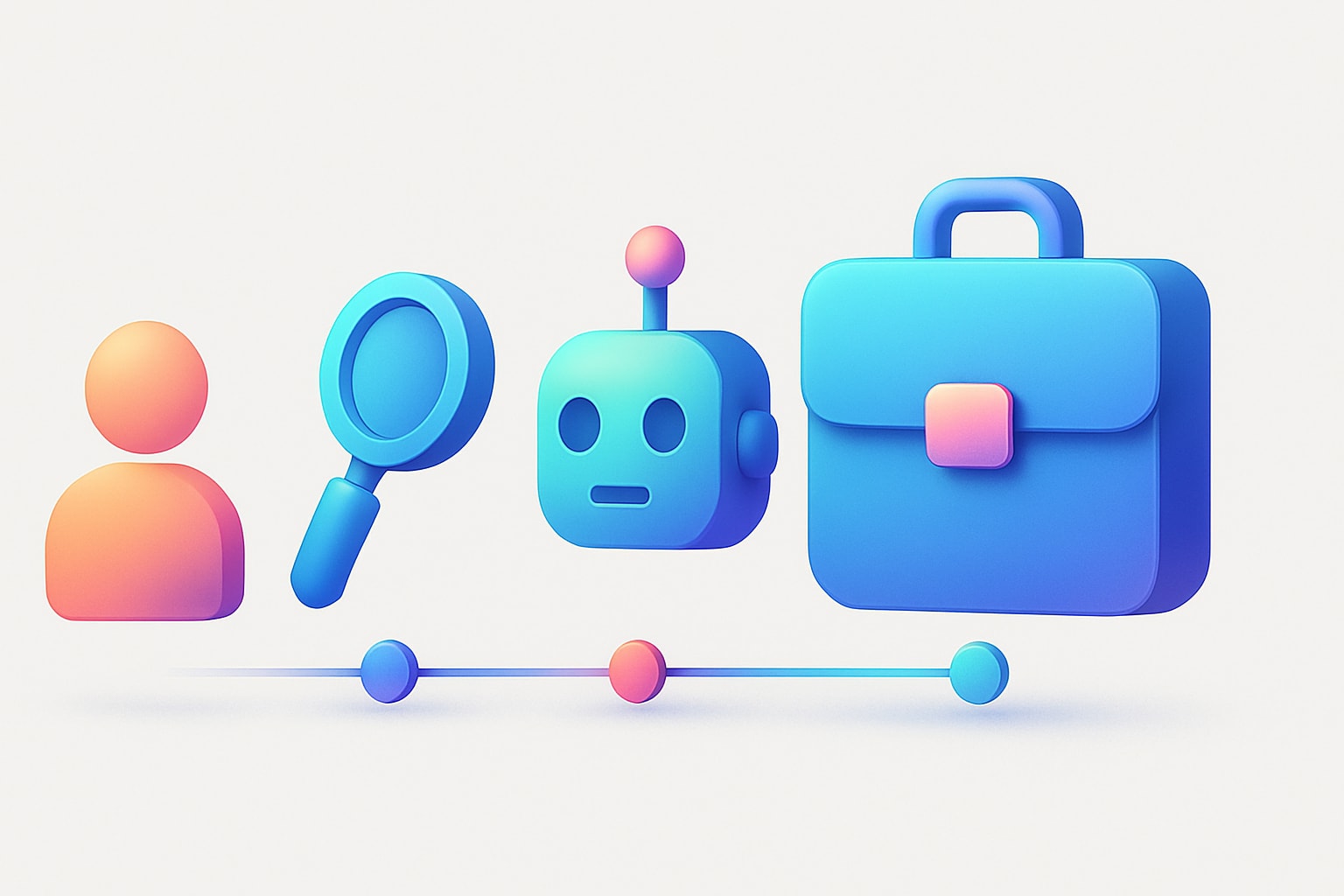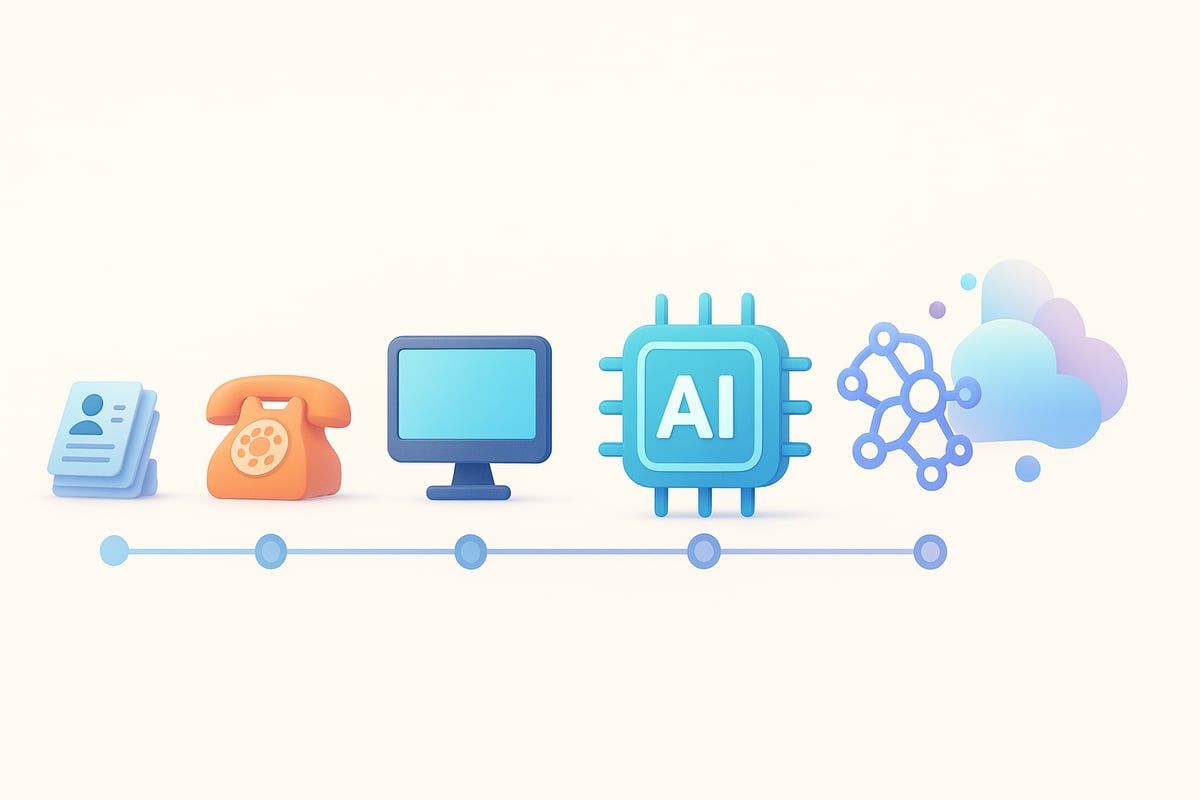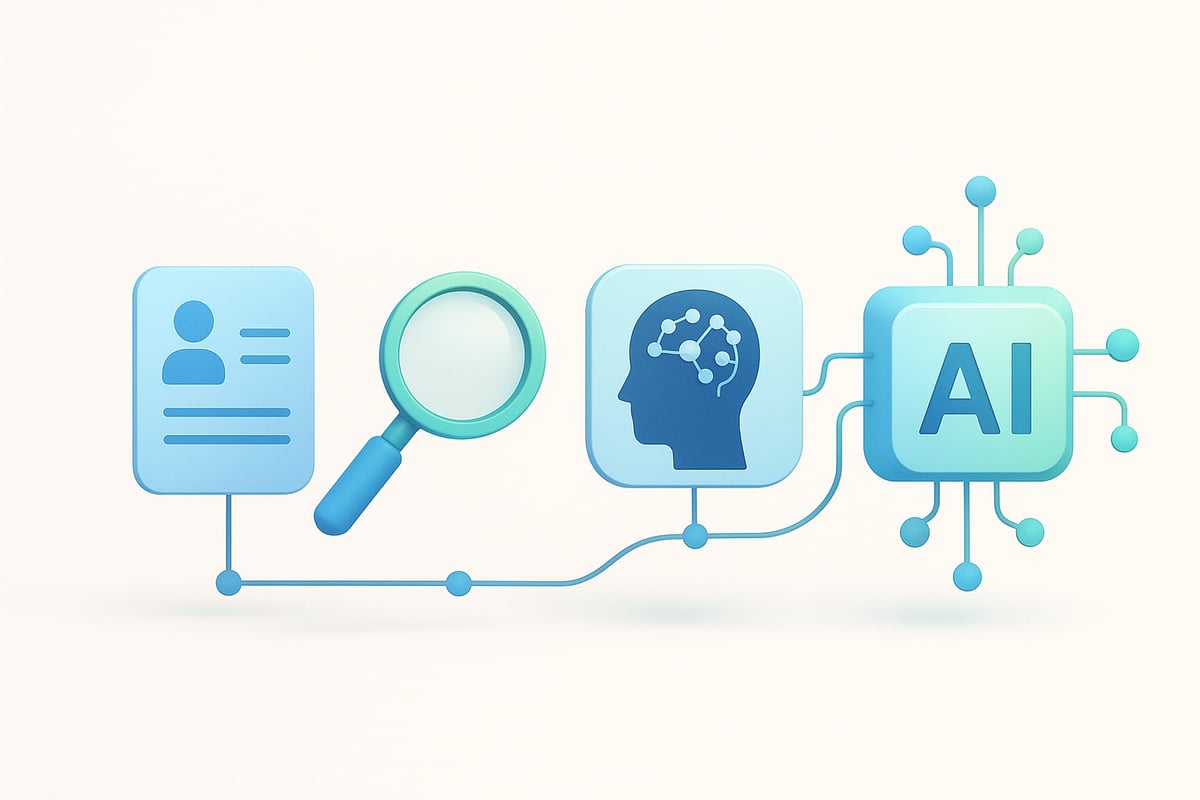October 21, 2025
Recruitment With AI: The Definitive Guide for 2025

AI is reshaping every aspect of recruitment in 2025, forcing HR leaders and recruiters to rethink their strategies. The demand for smarter, faster hiring means that recruitment with ai is no longer optional but essential for staying ahead. This guide offers a comprehensive, hands-on roadmap to recruitment with ai, covering proven benefits, clear integration steps, best practices, real-world results, and future trends. Discover how you can boost efficiency, reduce bias, and gain a decisive edge in talent acquisition. The time to embrace recruitment with ai is now—let this guide show you how.
The Evolution of Recruitment: From Traditional to AI-Driven
Recruitment has always been a people-centric process, but its earliest forms were burdened by manual tasks. Recruiters sifted through stacks of paper resumes, conducted phone screens, and relied heavily on gut feeling. These traditional methods left room for human bias, inconsistent evaluations, and significant inefficiencies. For decades, organizations struggled to attract and assess talent efficiently, often missing out on top candidates due to slow or subjective processes. As the talent market became more competitive, the need for transformation in recruitment with ai became increasingly urgent.
The digital age brought applicant tracking systems (ATS) and online job boards, which promised faster and broader reach. While these tools streamlined some administrative work, they could not fully address persistent challenges. Legacy ATS platforms often lacked intelligent matching and offered limited analytics. Recruiters still spent countless hours reviewing resumes and struggled with unconscious bias in hiring decisions. This created a gap between technology’s potential and actual impact, highlighting the limits of early digital recruitment with ai solutions.
The game changed with the arrival of artificial intelligence. AI-powered recruitment with ai leverages machine learning, natural language processing, and advanced data analytics to overhaul every stage of hiring. AI can analyze vast datasets, identify patterns in candidate profiles, and screen for skills and experience with unmatched speed. Natural language processing enables systems to interpret and assess resumes and cover letters, while predictive analytics forecast candidate success. These technologies have redefined what’s possible in recruitment with ai, making hiring more efficient, objective, and scalable.
Adoption of recruitment with ai has accelerated rapidly. According to a Gartner 2024 report, 43% of enterprises now use AI in recruitment, and industry research shows the trend is only growing. For more detailed insights, see these AI adoption in recruitment statistics. AI addresses critical pain points: it speeds up sourcing and screening, reduces human bias, and enables organizations to scale their hiring efforts without sacrificing quality. Companies that have embraced recruitment with ai report measurable improvements, including faster time-to-hire and higher quality-of-hire metrics.
Real-world examples show the shift in action. Leading firms in technology and finance have transitioned from traditional recruitment to recruitment with ai, reducing time-to-hire by up to 60%. Organizations like IBM and Unilever have integrated AI tools to automate initial screenings, resulting in more diverse talent pools and stronger candidate matches. These case studies demonstrate that recruitment with ai is not just a trend, but a strategic move that delivers tangible business results.
As we move forward, recruitment with ai is set to become the industry standard. The transformation from manual processes to AI-driven systems is reshaping how organizations compete for talent. This evolution lays the groundwork for best practices, integration steps, and future trends that will define recruitment success in 2025 and beyond.

How AI Transforms the Recruitment Process: Step-by-Step Guide
The recruitment landscape in 2025 is rapidly evolving, with recruitment with ai now at the forefront of modern talent acquisition. By integrating AI at each stage, organizations achieve unprecedented scale, speed, and precision. This section breaks down the recruitment workflow to show exactly where and how AI brings measurable value.
Recruiters and HR leaders are seeing firsthand the impact of AI, from reducing manual workload to enhancing candidate experience. As we move through each step, consider how these technologies can transform your own hiring process for better results.

Step 1: AI-Optimized Job Descriptions
The first step in recruitment with ai is transforming how job descriptions are crafted. AI-driven language analysis reviews postings for bias, clarity, and inclusivity. It suggests alternative phrasing that appeals to a broader talent pool and ensures compliance with diversity goals.
Companies using AI for job descriptions have reported increased application rates, especially from underrepresented groups. By analyzing large datasets, AI can identify language that unintentionally deters qualified candidates. This step not only boosts reach but also aligns job ads with company values and culture.
AI-powered optimization enables organizations to attract top talent more effectively, setting the tone for a fair and efficient recruitment with ai process. When job postings are clear and inviting, candidate diversity rises and the quality of applicants improves noticeably.
Step 2: Intelligent Sourcing and Talent Pooling
After the job post is live, recruitment with ai accelerates candidate sourcing. AI algorithms scan millions of online profiles, resumes, and social network data to find the best-fit candidates. These systems assess skills, experience, and even career trajectory, predicting who will thrive in the role.
This intelligent matching drastically reduces sourcing time compared to manual searches. For example, some organizations have seen sourcing times cut in half after implementing AI-powered tools. Instead of wading through endless profiles, recruiters receive ranked lists of high-potential candidates.
AI also helps build dynamic talent pools, continuously updating candidate data and surfacing passive talent when relevant roles open. This proactive approach ensures recruitment with ai is always one step ahead in the talent market.
Step 3: Automated CV Screening and Ranking
Screening and ranking CVs is one of the most time-consuming aspects of recruitment with ai, but AI-driven automation changes the game. Advanced software parses resumes, extracts relevant skills, and scores candidates based on job requirements.
According to recent studies, AI screening can reduce manual review time by up to 75%. Recruiters can instantly generate a shortlist from hundreds of applicants, ensuring no strong candidate is overlooked due to information overload.
AI-powered screening also minimizes human error and fatigue, leading to more consistent and objective evaluations. For a deep dive into how this works, explore the AI in the Recruitment Process guide, which details each automation step.
Step 4: Engaging and Communicating with Candidates
Effective engagement is crucial in recruitment with ai. AI chatbots and automated messaging tools initiate conversations, answer candidate questions, and provide updates throughout the process. These systems are available 24/7, making the experience seamless for candidates in any time zone.
Automated scheduling further reduces friction, allowing candidates to book interviews at their convenience. Companies report higher response rates and lower dropout rates when using AI-powered engagement tools.
By maintaining timely, personalized communication, recruitment with ai ensures candidates feel valued and informed. This not only improves the candidate experience but also strengthens the employer brand.
Step 5: Unbiased Shortlisting and Interview Preparation
One of the most powerful aspects of recruitment with ai is its capacity to remove unconscious bias from shortlisting and interview preparation. AI evaluates candidates solely on relevant criteria, ensuring fair consideration for all.
It also generates structured, competency-based interview questions tailored to each role. This leads to more objective assessments and helps interviewers stay focused on job-related skills.
Studies show that companies using AI for shortlisting experience improved diversity in their candidate pools. The result is a more equitable hiring process, driven by data rather than gut instinct.
Step 6: AI-Driven Assessments and Predictive Analytics
The final step in recruitment with ai involves AI-driven assessments and predictive analytics. These tools evaluate not just technical skills but also cultural fit and future job performance.
By analyzing assessment results and historical hiring data, AI predicts which candidates are most likely to succeed and stay long-term. Organizations report significant improvements in quality-of-hire and employee retention after adopting predictive analytics.
With these insights, recruiters make data-driven decisions, minimizing costly hiring mistakes. Recruitment with ai at this stage ensures every hire is a strategic asset, bringing measurable value to the organization.
Benefits and Challenges of AI in Recruitment
Recruitment with ai is rapidly shifting the talent acquisition landscape, offering both significant benefits and notable challenges for organizations. Companies are embracing this technology to streamline hiring, yet questions about fairness, privacy, and ethics remain at the forefront.
Recruitment with ai delivers measurable improvements in speed and efficiency. Automated resume screening, intelligent sourcing, and chatbots accelerate the process, reducing time-to-hire and administrative burden. According to recent reports, organizations using recruitment with ai have seen hiring times decrease by up to 35 percent, while quality-of-hire metrics have improved by 50 percent.
Another advantage of recruitment with ai is its ability to enhance candidate experience. Applicants now receive prompt, personalized communication, leading to higher engagement and satisfaction. AI-driven systems can analyze candidate feedback and optimize touchpoints, making the process smoother for everyone involved. For a deeper dive into these benefits and how they translate into real business outcomes, see Benefits of AI in Recruitment.
Bias reduction is a critical promise of recruitment with ai. AI algorithms, when properly designed and monitored, can minimize unconscious bias by focusing on objective data rather than subjective opinions. This supports fairer shortlisting and more inclusive hiring practices. Additionally, recruitment with ai empowers HR teams to make decisions guided by data, boosting transparency and accountability.
Despite these advantages, organizations must navigate several challenges. Algorithmic bias can persist if training data is flawed or if systems are not regularly audited. Transparency remains a concern, as candidates and recruiters alike may not fully understand how ai decisions are made. Data privacy, especially under regulations like GDPR and EEOC guidelines, adds complexity to implementation.
Balancing automation with the human touch is another hurdle. While recruitment with ai can handle repetitive tasks, candidates often value personal interaction during key stages. HR leaders stress the importance of combining technology with empathy, ensuring that automation supports, rather than replaces, human judgment.
Case studies reveal both successes and pitfalls. Some companies report dramatic reductions in cost-per-hire and improved retention rates after adopting recruitment with ai. Others encounter resistance from candidates skeptical of automated decisions or face setbacks due to insufficient oversight. Regular audits, clear communication, and ongoing training are essential strategies for sustainable adoption.
Ultimately, recruitment with ai offers a powerful toolkit for modern talent acquisition. Yet, realizing its full potential requires vigilance, ethical stewardship, and a commitment to continuous improvement.

Addressing Bias and Ensuring Fairness
Recruitment with ai is often seen as a tool to fight bias in hiring, but its effectiveness depends on thoughtful implementation. AI can help remove names, photos, and other demographic details from candidate profiles, allowing for more objective evaluation. However, recruitment with ai is only as fair as the data and logic behind it.
Organizations using recruitment with ai must regularly audit their algorithms to detect and correct any patterns of discrimination. This involves reviewing outcomes for different demographic groups and adjusting models to ensure equitable treatment. Transparency in how recruitment with ai systems make decisions is crucial for building trust among candidates and stakeholders.
Best practices include involving diverse teams in system design, using explainable AI models, and maintaining human oversight. These steps help ensure recruitment with ai not only reduces bias but also promotes fairness and diversity throughout the hiring process.
Data Privacy and Compliance Considerations
Protecting candidate data is a top priority in recruitment with ai. AI systems often process large volumes of sensitive information, making robust security measures essential. Recruitment with ai solutions must comply with global regulations such as GDPR in Europe and EEOC standards in the United States.
To safeguard privacy, organizations should implement data encryption, limit access to sensitive information, and maintain clear consent processes. Regular audits of recruitment with ai data handling practices help identify potential vulnerabilities and ensure ongoing compliance.
Candidates are increasingly aware of how their data is used. Transparent communication about recruitment with ai processes, data storage, and retention policies fosters trust and reduces skepticism. HR leaders recommend ongoing training for staff and periodic reviews of compliance protocols to keep pace with evolving legal standards.
A thoughtful approach to privacy and compliance not only protects organizations but also strengthens their employer brand. As recruitment with ai becomes more widespread, adherence to these principles will be a key differentiator in attracting and retaining top talent.
Real-World Success Stories and Use Cases
The business landscape is rapidly shifting as recruitment with ai moves from theory to practice. Across industries, organizations are reporting measurable gains in speed, quality, and diversity by integrating advanced AI solutions into their hiring workflows. These real-world examples reveal how recruitment with ai is redefining the way companies attract and select talent.
Tech Industry: IBM’s Intelligent Talent Acquisition
IBM stands out as an early adopter of recruitment with ai, integrating machine learning and natural language processing into its global hiring strategy. By automating resume screening and candidate matching, IBM reduced time-to-hire by 30%. The company’s AI-driven approach led to a 20% improvement in candidate quality and a more diverse talent pool. According to AI's impact on hiring efficiency, organizations using similar tools report up to 35% faster hiring times and a 50% boost in quality of hire, reinforcing the value of recruitment with ai in the tech sector.
Healthcare: Cleveland Clinic’s Enhanced Screening
Cleveland Clinic, one of the world’s leading medical institutions, turned to recruitment with ai to address the challenge of quickly filling critical roles. AI-powered platforms now analyze vast pools of applications, identifying top candidates based on skills and cultural fit. As a result, the clinic saw its time-to-hire drop from 45 days to just 20. Not only did candidate quality improve, but diversity in hires also increased, reflecting AI’s ability to remove human bias from early screening. This shift enabled HR teams to focus on strategic decision-making rather than manual resume reviews.
Finance: Unilever’s Global Digital Transformation
Unilever reimagined recruitment with ai for its finance and management trainee programs. The company implemented digital assessments and AI-driven video interviews across dozens of countries. This strategy resulted in a 50% reduction in time-to-hire and significant cost savings. Unilever also reported a marked increase in candidate satisfaction, as applicants experienced a more transparent and engaging process. As recruitment with ai becomes standard in finance, firms like Unilever demonstrate the scalability and consistency that AI brings to high-volume, global hiring.
Retail: Walmart’s Automated Candidate Engagement
Walmart, facing high turnover and seasonal hiring spikes, adopted recruitment with ai to streamline its entry-level hiring. AI chatbots and automated scheduling tools now handle initial candidate engagement, freeing recruiters for personal interactions with top talent. This automation led to a 40% reduction in manual administrative work and a quicker path from application to offer. Walmart’s experience highlights how recruitment with ai delivers both efficiency and a more responsive applicant journey.
How AI-Powered Recruitment Software Streamlines Shortlisting
Across these industries, several lessons emerge for organizations considering recruitment with ai. Success depends on setting clear objectives, ensuring human oversight, and continually refining AI models based on feedback. Companies that invest in recruiter upskilling and transparent communication see the greatest returns. As adoption accelerates, the most effective teams will balance automation with a personal touch, leveraging recruitment with ai to build agile, high-performing workforces.

Future Trends in AI Recruitment: What to Expect in 2025 and Beyond
Recruitment with ai is entering a new era, transforming the way organizations connect with top talent. As we look toward 2025 and beyond, the pace of innovation is accelerating, bringing both exciting opportunities and critical challenges. HR leaders and recruiters are facing a landscape where traditional methods are no longer enough to compete for the best candidates.
The rapid advancement of recruitment with ai is driven by a surge in adoption. According to AI recruitment adoption trends, 53 percent of organizations increased their use of AI in hiring between 2023 and 2024. This growth is matched by projections showing continued expansion of the AI recruitment market in the coming years.
New technologies such as generative AI, explainable algorithms, and real-time assessments are redefining every stage of recruitment with ai. Let’s explore the most significant trends shaping the future and how recruiters can prepare to lead in this evolving environment.
The Rise of Generative AI and Personalization
Generative AI is poised to become a game-changer for recruitment with ai. Unlike earlier tools that focused on automation and efficiency, generative models create highly personalized candidate experiences. These systems craft tailored outreach messages, design adaptive assessments, and even simulate real-world job scenarios based on each applicant’s unique profile.
This level of personalization is not just about engagement, it is also about brand differentiation. Employers leveraging recruitment with ai can present a compelling, authentic employer brand that resonates with candidates on an individual level. For example, generative AI can analyze candidate interests and accomplishments, then design custom video introductions or interactive job previews that boost application rates.
The impact on recruitment with ai is profound. Companies adopting these solutions see higher response rates, improved candidate satisfaction, and stronger talent pipelines. As generative AI capabilities continue to mature, expect hyper-personalized interactions to become the standard for forward-thinking organizations.
Building Trust and Transparency in AI Hiring
With the growing influence of recruitment with ai, trust and transparency are moving to the forefront. Candidates and hiring managers want to understand how AI-driven systems make decisions. Explainable AI is emerging as a key trend, offering insights into why certain candidates are shortlisted or evaluated in specific ways.
Recruiters must prioritize ethical standards and clear communication throughout the recruitment with ai process. This includes providing feedback mechanisms, outlining how data is used, and ensuring compliance with evolving regulations. As more organizations embrace recruitment with ai, building robust frameworks for fairness and accountability becomes essential for long-term success.
Looking ahead, the future of recruitment with ai will depend on the industry’s ability to balance innovation with responsibility. By adopting transparent practices and maintaining a human touch, organizations can establish trust while reaping the benefits of advanced AI-powered recruitment.
